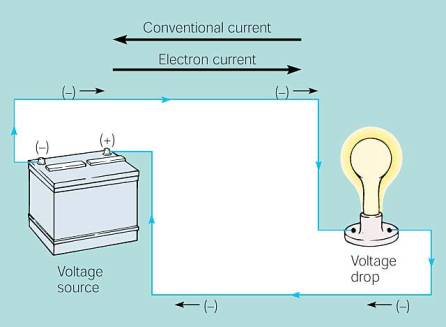
The Ampere
(Section 5.8)
A flow of charge from one place to another is an electric current. We can see a current in a simple circuit using a battery as a electromotive source. In a battery, a chemical reaction is taking place that causes electrons to move. We then harness these electrons by forcing them to go through a wire.

We can see the effects of this electron flow with the light bulb,
which
converts some of the energy of this movement to light. The light bulb
also gets
hot so it is converting some of the energy to heat. Light bulbs and
heating
elements are examples of resistors, they impede the flow of electrons.
The flow of electrons is called current
and is measured in amperes (A). An ampere is equal to a flow of 1
coulomb/second.
A conventional current describes positive charges moving from the positive terminal (+) to the negative terminal (-). You may see this convention in circuit diagrams in physics books. Chemists describe electron current as negative charges (-) moving from the negative terminal (-) to the positive terminal (+). This would seem to make more sense, as it is electrons that are moving. (sort of….)
Actually, individual electrons move very slowly. With a drift velocity of 0.01 cm/s, more than 5 hr would be required for an electron to travel 200 cm from a car battery to the brake light. What actually happens is than an electron "pushes" another electron, which "pushes" another electron and so on down the length of the wire. Therefore, it is the electric field, not the electrons, which moves at near the speed of light in an electric circuit.
There are four factors that influence the resistance of an electrical conductor. They are the length of the conductor, the cross-sectional area of the conductor, the material the conductor is made of, and the temperature of the conductor.
We have seen batteries run motors so we know they can do work. How much? The answer is it depends on the push from the battery. This push is called the electrical potential or voltage and is the electric potential energy per amount of charge. It is measured in voltage. 1 volt = J/C